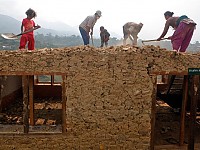
A vague plan and the debris from the April 25 earthquake that rocked the nation, killing more than 8000 people, are hindering Nepal’s effort to rebuild in a better manner. Only a limited amount of time is available for doing urgent reconstruction work between the end of monsoon in September and the start of the severe winter season.
As many as 600,000 homes and 300,000 other buildings were damaged in the earthquake, according to data released by the government. Currently, shops and schools are being run in makeshift dwellings put up amidst the debris and rubble. Debris that continues to block roads, hazy government guidelines and demolition activities that are progressing at snail’s pace are seriously affecting the rebuilding process.
Meanwhile, the Sendai Framework that the UN General Assembly adopted in March outlines “Build Back Better” as one of the four priorities, when it comes to reconstructing activities, as a safeguard against future disasters. As a result, Nepal will be the testing ground, especially because the earthquake was the first disaster to occur immediately after the adoption of the framework.
As the demolition work is progressing very slowly, homeowners are involving themselves in demolition work in many of rural and historical urban areas. Bulldozers have been provided by some municipalities, but people are forced to use basic hand tools like chisels and levers to do the demolition work. Further, there is a dearth of expert supervision, which has resulted in increased risk for workers, adjacent properties and bystanders. The lack of resources is also a matter of great concern.
According to Renaud Meyer, country director in Nepal for UN Development Program, the international community has pledged $4.4 billion, but most of it is for reconstruction and not debris management. He has suggested two ways to raise funds for demolition: one is mobilization of additional funds, which does not create any interest in donors, and the other is diversion of a part of the funds allocated for reconstruction.
As regards reconstruction, Nepal government has promised several benefits to victims. These include an initial grant of $144, second grant of $1,922 and 2 percent interest loans for home rebuilding. However, there is a great deal of confusion about disbursement of these grants because population estimates as of 2011 are only available. Additionally, the fact that the grants would not be sufficient for building new homes is adding to the concerns.
Moreover, experts fear that people might end up constructing houses that are dangerous because of lack of guidance from the government’s side and awareness about what materials are to be used when reconstructing building after an earthquake. Som Paneru, executive director of the NGO Nepal Youth Foundation, said that the biggest dilemma being faced by people in rural areas is how they should go about rebuilding their homes and other buildings.
Some experts are of the opinion that the delay in establishing the National Reconstruction Authority, formed in June, to oversee implementation of durable, planned and sustainable reconstruction work has added to the confusion. The CEO of the Authority was appointed only on August 14, about four months after the disaster.
However, the spokesperson of the Ministry of Home Affairs, Laxmi Prasad Dhakal, said that necessary guidelines will be issued as soon as the Ministry of Finance finalizes the provisions for grants and loans. Further, Amod Mani Dixit, executive director, National Society for Earthquake Technology in Nepal, said that the proposed construction technology, shelter designs and delivery systems will be released soon. He added that the reconstruction work is expected to start after the monsoon and would in all probability be completed in five years as outlined in the Post Disaster Needs Assessment.










